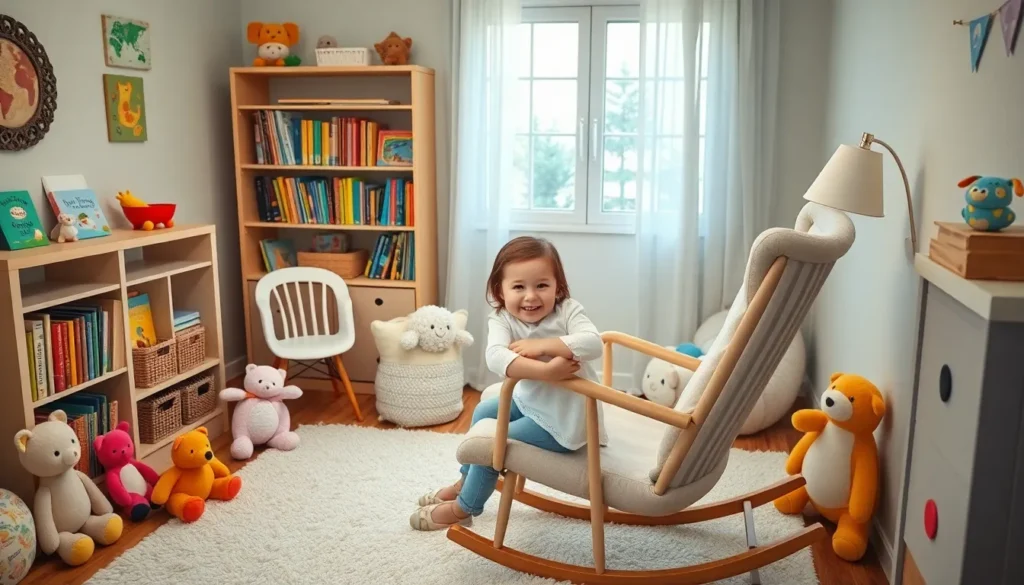Choosing the right books for babies can spark a love for reading that lasts a lifetime. With vibrant illustrations and engaging stories, the best baby books not only entertain but also promote essential early development skills. From board books that withstand tiny hands to picture books that ignite imagination, there’s a world of options to explore.
Parents and caregivers often find themselves overwhelmed by countless titles. This guide highlights the most beloved and effective baby books that captivate young minds. Whether it’s fostering language skills or nurturing bonding moments, these selections promise to enrich the reading experience for both child and adult alike. Dive into the enchanting realm of baby literature and discover the perfect stories to share.
Table of Contents
ToggleBest Baby Books: An Overview
Selecting the best baby books involves considering vibrant illustrations, engaging stories, and interactive elements. These factors significantly impact babies’ early development skills.
Popular Titles
- Goodnight Moon
Developed by Margaret Wise Brown, this classic bedtime story combines simple rhymes with cozy illustrations. It fosters a calming bedtime routine.
- The Very Hungry Caterpillar
Eric Carle’s iconic tale features bright colors and a captivating storyline, encouraging counting and days of the week awareness.
- Where’s Spot?
This interactive lift-the-flap book by Eric Hill engages babies, promoting curiosity and tactile development through its playful format.
- Brown Bear, Brown Bear, What Do You See?
Bill Martin Jr. and Eric Carle together crafted a rhythmic text that introduces colors and animals, aiding language development.
- Chicka Chicka Boom Boom
This fun alphabet book by Bill Martin Jr. entertains with its catchy rhythm and bright illustrations while reinforcing letter recognition.
Benefits of Reading
Reading aloud to babies strengthens parent-child bonds and enhances language exposure. Engaging with books encourages listening skills and imagination, laying the groundwork for future literacy.
Key Considerations
- Age Appropriateness
Choose books suitable for a baby’s developmental stage, focusing on board books for durability and snuggly sizes.
- Diversity of Content
Select books that encompass diverse characters and cultures, reinforcing inclusivity and broadening understanding.
- Interactive Features
Look for books with textures, flaps, or mirrors, as these elements stimulate sensory exploration and keep babies engaged.
Benefits of Reading to Babies

Reading to babies offers numerous advantages, significantly influencing their growth and development. Engaging with books early fosters vital skills that support overall well-being.
Cognitive Development
Reading to babies stimulates cognitive development by enhancing language skills and promoting critical thinking. Exposure to varied vocabulary, sentence structures, and concepts lays a solid foundation for language acquisition. It aids in memory retention as babies begin to recognize repetitive phrases and familiar stories. Interactive books that encourage participation also nurture cognitive skills, fostering problem-solving abilities as infants learn to engage with their environment.
Emotional Bonding
Reading together creates opportunities for emotional bonding between parents and babies. The shared experience of storytime fosters a sense of security and comfort. Infants develop trust through the warmth of their caregiver’s voice and presence during reading sessions. Moreover, the routine of reading cultivates a nurturing environment, encouraging emotional growth and attachment. Engaging with stories that evoke a range of emotions reinforces empathy in babies, helping them connect with others.
Criteria for Selecting Baby Books
Selecting the right baby books involves several critical criteria that significantly enhance a child’s early reading experience and development. Key factors include age appropriateness, engaging illustrations, and a balance of text that invites interaction.
Age Appropriateness
Age appropriateness is crucial for selecting baby books. Books should cater to a child’s developmental stage, as different age groups exhibit varying interests and comprehension levels. Board books suit infants and toddlers due to their durable construction and simple concepts. Picture books, ideal for ages two to five, introduce more elaborate narratives while maintaining engaging visuals. For older toddlers, interactive books or lift-the-flap options encourage exploration and curiosity.
Illustrations and Text
Illustrations and text work together to captivate babies’ attention. Bright, contrasting colors and playful images stimulate visual interest, fostering engagement and focus during reading sessions. Simple, rhythmic text paired with illustrations reinforces language acquisition as babies associate images with words. Additionally, engaging storytelling, even in minimal print, encourages infants to immerse themselves in the narrative. Books featuring diverse themes and relatable characters also promote inclusivity and broaden a child’s understanding of the world around them.
Top Picks for Best Baby Books
Selecting the best baby books involves considering titles that engage and educate while fostering a love for reading. The following recommendations include classic favorites and exciting new arrivals.
Classic Favorites
- Goodnight Moon
This timeless bedtime story features gentle rhythms and soothing illustrations that create a calming atmosphere, perfect for winding down. It’s known for introducing simple concepts to very young readers.
- The Very Hungry Caterpillar
This beloved tale combines fun illustrations with an engaging story about metamorphosis. The unique design allows babies to explore the concept of counting and the days of the week.
- Where’s Spot?
This interactive lift-the-flap book invites infants to discover where the mischievous puppy is hiding. It promotes curiosity and encourages participation, making it a favorite among parents and caregivers.
- Brown Bear, Brown Bear, What Do You See?
This rhythmic, repetitive text engages the audience while introducing colors and animals. Its predictable pattern enriches language development and recognition skills.
- Chicka Chicka Boom Boom
This lively counting rhyme teaches the letters of the alphabet in a playful manner. The vibrant illustrations and rhythmic text make it appealing for interactive reading sessions.
New Arrivals
- Baby Shark’s Big Show!
Based on the viral song, this book features engaging illustrations and a catchy story that entertains while reinforcing social skills through themes of friendship and teamwork.
- If Animals Kissed Good Night
This new twist on traditional goodnight stories showcases various animals and their unique ways of saying goodnight. The delightful illustrations and gentle prose make it perfect for bedtime.
- My First Book of Colors
This interactive book introduces colors with bright visuals and simple text. It’s an excellent choice for sensory exploration as babies learn to identify colors in their surroundings.
- The Pigeon Will Ride the Roller Coaster!
This engaging story captures the excitement of the roller coaster while presenting relatable emotions. It helps build vocabulary and confidence in expressing feelings.
- What Should Danny Do?
This interactive story invites kids to make choices, allowing them to explore consequences in a fun way. It encourages critical thinking and decision-making skills.
Tips for Reading with Your Baby
Engaging in reading time with a baby encourages bonding and aids development. Follow these tips to make the most of storytime:
- Choose age-appropriate books: Select titles that fit the baby’s developmental stage. For infants, board books with simple images work best. Toddlers benefit from picture books with engaging stories.
- Create a comfortable environment: Settle into a cozy space with soft lighting. Ensure the baby is comfortable in a secure position for better interaction during reading.
- Use expressive voices: Vary tone, pitch, and volume to make the story captivating. Expressiveness can grab attention and foster understanding.
- Point out illustrations: Discuss pictures to encourage visual exploration. Ask questions about the images to stimulate cognitive thinking.
- Encourage participation: Invite the baby to touch the book or turn pages. Interactive reading promotes motor skills and cognitive awareness.
- Revisit favorite stories: Familiarity builds comfort. Reading the same book fosters attachment and enhances memory recall through repetitive exposure.
- Limit distractions: Reduce noise and clutter during reading time. A focused environment enhances engagement and comprehension.
- Make it a routine: Establish a reading routine to create consistency. Daily reading promotes language exposure and cognitive development.
- Be patient and flexible: Every baby has different attention spans. Feel free to adjust the reading time based on the baby’s response.
Choosing the right baby books can significantly influence a child’s early development and foster a love for reading. Engaging stories and vibrant illustrations not only capture attention but also enhance language skills and cognitive growth.
Parents and caregivers have a wealth of options to explore, from timeless classics to innovative new titles. By focusing on age-appropriate selections and interactive features, they can create enriching reading experiences that strengthen bonds and promote emotional development.
Establishing a routine around reading will make storytime a cherished part of daily life, laying a strong foundation for literacy and a lifelong passion for books. The journey of discovering the world through stories starts with those first pages, making every choice an important step in nurturing a child’s future.







